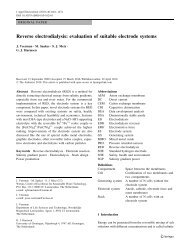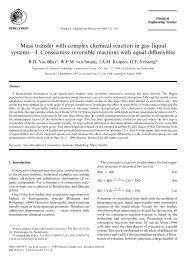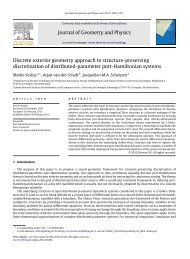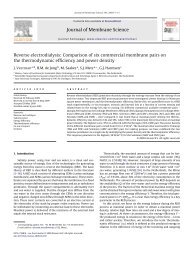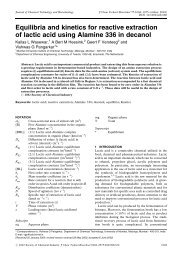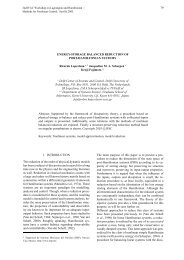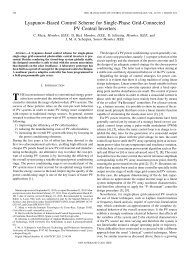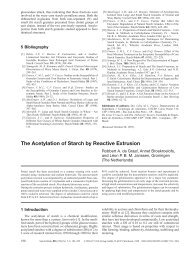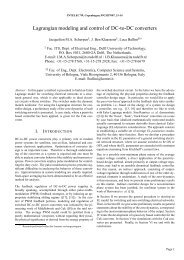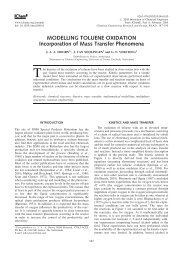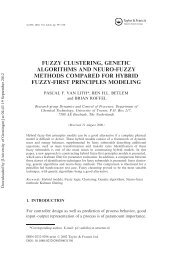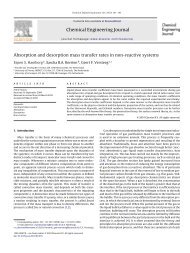Synthesis of poly-(ε)-caprolactone grafted starch co-polymers by ring ...
Synthesis of poly-(ε)-caprolactone grafted starch co-polymers by ring ...
Synthesis of poly-(ε)-caprolactone grafted starch co-polymers by ring ...
Create successful ePaper yourself
Turn your PDF publications into a flip-book with our unique Google optimized e-Paper software.
Carbohydrate Polymers 77 (2009) 267–275<br />
Contents lists available at ScienceDirect<br />
Carbohydrate Polymers<br />
journal homepage: www.elsevier.<strong>co</strong>m/locate/carbpol<br />
<strong>Synthesis</strong> <strong>of</strong> <strong>poly</strong>-(e)-<strong>caprolactone</strong> <strong>grafted</strong> <strong>starch</strong> <strong>co</strong>-<strong>poly</strong>mers <strong>by</strong> <strong>ring</strong>-opening<br />
<strong>poly</strong>merisation using silylated <strong>starch</strong> precursors<br />
Asaf K. Sugih, Frances<strong>co</strong> Picchioni, Leon P.B.M. Janssen, Hero J. Heeres *<br />
Chemical Enginee<strong>ring</strong> Department, Rijksuniversiteit Groningen, Nijenborgh 4, Groningen 9747AG, The Netherlands<br />
article<br />
info<br />
abstract<br />
Article history:<br />
Received 21 July 2008<br />
Received in revised form 3 December 2008<br />
Accepted 23 December 2008<br />
Available online 14 January 2009<br />
Keywords:<br />
Starch<br />
Biodegradable <strong>poly</strong>mers<br />
Grafting<br />
Poly<strong>caprolactone</strong><br />
Silylation<br />
Poly-(e)-<strong>caprolactone</strong> <strong>grafted</strong> <strong>co</strong>rn <strong>starch</strong> <strong>co</strong>-<strong>poly</strong>mers were synthesized using a hydrophobised silylated<br />
<strong>starch</strong> precursor. The silylation reaction was performed using hexamethyl disilazane (HMDS) as the<br />
reagent in DMSO at 70 °C. Silylated <strong>starch</strong> with a degree <strong>of</strong> substitution (DS) between 0.45 and 0.7<br />
was obtained. e-Caprolactone is <strong>grafted</strong> to silylated <strong>starch</strong> <strong>by</strong> a <strong>ring</strong>-opening <strong>poly</strong>merisation catalysed<br />
<strong>by</strong> Al(OiPr) 3 in THF at 50 °C. The grafting efficiency varies between 28% and 58%, the remainder being<br />
homo<strong>poly</strong>mers <strong>of</strong> e-<strong>caprolactone</strong>. The DS <strong>of</strong> the <strong>poly</strong><strong>caprolactone</strong> graft is between 0.21 and 0.72. The<br />
<strong>poly</strong>-(e)-<strong>caprolactone</strong> side chains <strong>co</strong>nsist <strong>of</strong> 40–55 monomer units and is a function <strong>of</strong> the reagent<br />
intakes. Experiments with native <strong>starch</strong> under similar <strong>co</strong>nditions do not result in the desired <strong>poly</strong>-(e)-<br />
<strong>caprolactone</strong> <strong>grafted</strong> <strong>co</strong>rn <strong>starch</strong> <strong>co</strong>-<strong>poly</strong>mers and unreacted <strong>starch</strong> was re<strong>co</strong>vered after work-up.<br />
Removal <strong>of</strong> the silyl groups <strong>of</strong> the <strong>poly</strong>-(e)-<strong>caprolactone</strong> <strong>grafted</strong> <strong>starch</strong> <strong>co</strong>-<strong>poly</strong>mers is possible using a<br />
mild acid treatment with diluted hydrochloric acid in THF at room temperature.<br />
Ó 2009 Elsevier Ltd. All rights reserved.<br />
1. Introduction<br />
Worldwide, 245 million tons <strong>of</strong> plastics are produced per year,<br />
and this value increases with about 10% per year (PlasticsEurope,<br />
2008). These plastics are mainly synthetic <strong>poly</strong>mers from fossil resources,<br />
which are known to degrade with difficulty and cause<br />
serious environmental problems (Yavuz & Babac, 2003). The development<br />
<strong>of</strong> green biodegradable <strong>poly</strong>mers for e.g. the future generation<br />
<strong>of</strong> packaging materials is highly desirable.<br />
Starch, a natural bio<strong>poly</strong>mer, is one <strong>of</strong> the potential candidates<br />
for future biodegradable <strong>poly</strong>mer products. Starch is abundantly<br />
available. Global production <strong>of</strong> <strong>starch</strong> is 60 million ton per year<br />
in 2004 (International Starch Institute, 2008). Starch is present in<br />
the body <strong>of</strong> many plants (tubers, roots) as granules or cells with<br />
typical particle sizes between 1 and 100 lm. The <strong>poly</strong>meric structure<br />
<strong>of</strong> <strong>starch</strong> <strong>co</strong>nsists <strong>of</strong> repeating anhydroglu<strong>co</strong>se units. There are<br />
two types <strong>of</strong> bio<strong>poly</strong>mer in <strong>starch</strong>, amylose (a linear <strong>poly</strong>mer <strong>of</strong><br />
anhydroglu<strong>co</strong>ses with a-D-1,4-glu<strong>co</strong>sidic bonds) and amylopectin<br />
(a branched <strong>poly</strong>mer with a-D-1,6-glu<strong>co</strong>sidic bonds besides a-D-<br />
1,4-glu<strong>co</strong>sidic bonds). The <strong>co</strong>ntent <strong>of</strong> amylose in <strong>starch</strong>es depends<br />
on the plant and typically varies between 18% and 28%. The amylose–amylopectin<br />
ratio in native as well as modified <strong>starch</strong>es has<br />
a strong impact on the product properties.<br />
Starch films are known to have good oxygen barrier properties.<br />
However, as <strong>starch</strong> is highly hydrophilic, it is water sensitive, and<br />
the mechanical properties <strong>of</strong> <strong>starch</strong>-based films are generally<br />
* Corresponding author. Tel.: +31 50 3634174; fax: +31 50 3634479.<br />
E-mail address: h.j.heeres@rug.nl (H.J. Heeres).<br />
inferior to those derived from synthetic <strong>poly</strong>mers (Krochta & De<br />
Mulder-Johnston, 1997; Tsiapouris & Linke, 2000). Starch modification<br />
is therefore needed to meet the product properties in a number<br />
<strong>of</strong> application areas. Various modification strategies have been<br />
explored, for instance grafting <strong>of</strong> monomers (like styrene and<br />
methyl methacrylate) to the <strong>starch</strong> backbone (Bagley, Fanta, Burr,<br />
Doane, & Russell, 1977; Beliakova, Aly, & Abdel-Mohdy, 2004).<br />
However, in almost all cases, the used monomers and the <strong>co</strong>rresponding<br />
<strong>grafted</strong> chains are not easily biodegradable. Starch has<br />
also been thermoplasticized with the help <strong>of</strong> plasticizers such as<br />
glycerol and other <strong>poly</strong>al<strong>co</strong>hols (Weber, 2000). However, the product<br />
properties are in most cases still not up to standards and blending<br />
with other <strong>poly</strong>mers is required (Wang, Yang, & Wang, 2003).<br />
A wide variety <strong>of</strong> synthetic biodegradable <strong>poly</strong>mers have been<br />
prepared. Well known examples are <strong>poly</strong>esters derived from cyclic<br />
lactones (<strong>poly</strong><strong>caprolactone</strong>, <strong>poly</strong>valerolactone and <strong>poly</strong>butyrolactone).<br />
Poly<strong>caprolactone</strong> (PCL) is easily degraded <strong>by</strong> micro-organisms<br />
(Karlsson & Albertsson, 1998). Aerobic soil-burial experiments<br />
showed that the mechanical properties <strong>of</strong> PCL films decreased rapidly<br />
in time and were fully degraded after 4 weeks (Goldberg,<br />
1995). PCL has gained much interest for possible applications in<br />
the medical field as well as in the area <strong>of</strong> packaging materials<br />
(Chandra & Rustgi, 1998; Chiellini & Solaro, 1996).<br />
Several studies to <strong>co</strong>mbine the properties <strong>of</strong> <strong>starch</strong> and PCL<br />
have been performed to obtain fully biodegradable materials with<br />
improved product properties. Blends <strong>of</strong> thermoplastic <strong>starch</strong> and<br />
PCL are not fully miscible, resulting in undesirable phase separation<br />
(Averous, Moro, Dole, & F<strong>ring</strong>ant, 2000). To increase the miscibility<br />
<strong>of</strong> <strong>starch</strong> and <strong>poly</strong><strong>caprolactone</strong>, it has been proposed to<br />
0144-8617/$ - see front matter Ó 2009 Elsevier Ltd. All rights reserved.<br />
doi:10.1016/j.carbpol.2008.12.032
268 A.K. Sugih et al. / Carbohydrate Polymers 77 (2009) 267–275<br />
chemically graft <strong>caprolactone</strong> onto the hydroxyl groups <strong>of</strong> <strong>starch</strong><br />
using <strong>ring</strong>-opening <strong>poly</strong>merisation (Dubois, Krishnan, & Narayan,<br />
1999). Common Ring-Opening Polymerization (ROP) catalysts such<br />
as tin octoate or aluminium isopropoxide gave low grafting efficiencies<br />
(GE, 0–14%). The highest GE (90%) was achieved using triethylaluminium<br />
as catalyst (Dubois et al., 1999). This catalyst is<br />
extremely air and water sensitive, therefore difficult to handle<br />
and releases ethane, a very flammable <strong>by</strong>-product, du<strong>ring</strong> the reaction.<br />
All available data indicate that the presence <strong>of</strong> water reduces<br />
the GE. This is rationalised <strong>by</strong> assuming that water <strong>co</strong>mpetes with<br />
the hydroxyl groups <strong>of</strong> <strong>starch</strong> in the initiation step <strong>of</strong> the <strong>poly</strong>merization<br />
reaction, thus leading to the formation <strong>of</strong> PCL homo<strong>poly</strong>mers<br />
rather that <strong>starch</strong>-g-PCL (Dubois et al., 1999). Another<br />
possible cause for the low grafting efficiencies is the heterogenous<br />
nature <strong>of</strong> the reaction. Starch is insoluble in the typical organic solvents<br />
used for ROP (such as toluene or THF), leading to a liquid–solid<br />
system. This is expected to lead to reduced reaction rates<br />
between <strong>starch</strong> and CL <strong>co</strong>mpared to CL homo<strong>poly</strong>merisation, thus<br />
to a reduction in the GE.<br />
In this paper, an alternative method to synthesize <strong>poly</strong>-(e)-<strong>caprolactone</strong><br />
<strong>grafted</strong> <strong>starch</strong> <strong>co</strong>-<strong>poly</strong>mers (<strong>starch</strong>-g-PCL) is reported.<br />
The <strong>starch</strong> source is made less hydrophilic and thus more soluble<br />
in organic solvents <strong>by</strong> substituting part <strong>of</strong> the OH groups <strong>of</strong> <strong>starch</strong><br />
<strong>by</strong> a bulky silyl group (Klemm & Einfeldt, 2001; Petzold, Klemm,<br />
Stein, & Gunther, 2002; Petzold, Koschella, Klemm, & Heublein,<br />
2003). In this way, the <strong>ring</strong>-opening <strong>poly</strong>merisation occurs solely<br />
in the liquid phase and this is expected to lead to higher GE values.<br />
This approach has also been applied successfully to graft PCL and<br />
<strong>poly</strong>lactide on dextran (Nouvel, Dubois, Dellacherie, & Six, 2004;<br />
Ydens et al, 2000).<br />
2. Materials and methods<br />
2.1. Materials<br />
Corn <strong>starch</strong> (Sigma) was dried under high vacuum (1 mbar) at<br />
100 °C for one day before use. Hexamethyldisilazane (HMDS, Acros)<br />
and methanol (Labscan) were used as received. DMSO (Acros)<br />
and toluene (Labscan) were dried overnight over molecular sieves<br />
3 Å (Merck) and stored under a protective nitrogen atmosphere.<br />
Dry tetrahydr<strong>of</strong>uran (THF) and toluene for <strong>poly</strong>merization experiments<br />
were obtained in closed vessels from Aldrich and were used<br />
as received. Hydrochloric acid (HCl) 1 N was prepared from Titrisol<br />
<strong>co</strong>ncentrated hydrochloric acid solution (Merck) and distilled<br />
(Milipore) water. e-<strong>caprolactone</strong> monomer (Fluka) was dried over<br />
Calcium Hydride (CaH 2 ) for 48 h, distilled under reduced pressure<br />
at 100 °C and stored under a protective nitrogen atmosphere.<br />
Aluminium triisopropoxide [Al(OiPr) 3 ] (Acros) was used without<br />
further purification. A stock solution was prepared <strong>by</strong> dissolving<br />
1.67 g (8 mmol) Al(OiPr) 3 in 50 ml <strong>of</strong> dry toluene in a glove box.<br />
2.2. Methods<br />
All reactions and manipulations with air-sensitive materials<br />
were carried out under a protective nitrogen atmosphere either<br />
using standard Schlenk techniques or in a glove box.<br />
2.2.1. Typical example <strong>of</strong> the <strong>starch</strong> silylation procedure<br />
The procedure for <strong>co</strong>rn <strong>starch</strong> silylation was adapted from that<br />
published for dextran (Nouvel, Dubois, Dellacherie, & Six, 2003;<br />
Nouvel et al., 2002; Nouvel et al., 2004; Rutot, Duquesne, Ydens,<br />
Degee, & Dubois, 2001; Ydens et al., 2000). For each experiment,<br />
pre-dried <strong>co</strong>rn <strong>starch</strong> (6 g) and dry DMSO (75 ml) were stirred at<br />
70 °C for about 3 h until a clear solution was formed. The predetermined<br />
amount <strong>of</strong> HMDS (typically 24 ml, 0.111 mol) was<br />
added to the gelatinized mixture to initiate the silylation reaction.<br />
The reaction was carried out at 70 °C. After 2 and 4 h reaction time,<br />
toluene (40 ml) was added to solubilize the precipitated (partially<br />
silylated) <strong>starch</strong>. After 6 h, another portion <strong>of</strong> toluene (20 ml) was<br />
added. After 24 h, the solvents were removed from the silylated<br />
<strong>starch</strong> product under reduced pressure (20 mbar) at 70 °C. Traces<br />
<strong>of</strong> DMSO trapped in the product were removed <strong>by</strong> dissolving the<br />
product in a small amount <strong>of</strong> toluene and re-precipitation in methanol.<br />
This procedure was repeated three times. After removal <strong>of</strong> the<br />
solvents under reduced pressure (0.1 mbar, 80 °C), the silylated<br />
<strong>starch</strong> (1) product was dried in a vacuum oven (5 mbar, 40 °C)<br />
until <strong>co</strong>nstant weight. The white-to-transparent solid products<br />
were stored under vacuum in a desiccator at 6–8 °C. The samples<br />
were characterized <strong>by</strong> 1 H NMR.<br />
Silylated Starch (1, before peracetylation, Sample SN-3,<br />
DS = 0.60): 1 H NMR (CDCl 3 ,50°C): d 0.12 (m, silyl–CH 3 ), 3–6 ppm<br />
(m, broad peaks, <strong>starch</strong>).<br />
Silylated Starch (1, after peracetylation, Sample SN-3,<br />
DS = 0.60): 1 H NMR (CDCl 3 ,50°C): d 0.12 (m, silyl–CH 3 ), 1.7-2.5<br />
(m, acetate–CH 3 ), 3–6 ppm (m, broad peaks, <strong>starch</strong>).<br />
2.2.2. Typical example <strong>of</strong> in situ <strong>poly</strong>merization <strong>of</strong> e-CL with silylated<br />
<strong>starch</strong><br />
The silylated product from the first step was dissolved in THF<br />
(0.6 mL) at 50 °C (1–2 h). The intake <strong>of</strong> 1 depended on its DS and<br />
was adjusted to obtain a solution with 5 10 5 mol free-OH<br />
groups/ml <strong>of</strong> THF. To this homogenous solution, THF (4.5 ml) and<br />
a predetermined amount <strong>of</strong> the stock solution <strong>of</strong> Al(OiPr) 3 in toluene<br />
were added. A mol ratio <strong>of</strong> –OH groups to catalyst <strong>of</strong> 10:1 was<br />
used. The mixture was stirred at 50 °C for 4 h to promote the exchange<br />
reaction between the isopropoxide groups <strong>of</strong> Al(OiPr) 3<br />
and the free –OH groups <strong>of</strong> <strong>starch</strong>. Subsequently, a predetermined<br />
amount <strong>of</strong> e-<strong>caprolactone</strong> monomer (molar ratio <strong>of</strong> monomer to<br />
OH-groups was 13:1 for a standard experiment) was added and<br />
the <strong>ring</strong>-opening <strong>poly</strong>merization reaction was allowed to proceed<br />
for 24 h at 50 °C. The reaction was stopped <strong>by</strong> <strong>co</strong>oling down the<br />
mixture to room temperature and the addition <strong>of</strong> 2–3 drops <strong>of</strong><br />
1 N HCl to deactivate the catalyst. The silylated <strong>starch</strong>-g-PCL (2)<br />
product was precipitated from the solution <strong>by</strong> the addition <strong>of</strong> heptane<br />
(about 250 ml) at 18 °C. The solid precipitate was filtered<br />
and dried under vacuum (5 mbar) at 40 °C for 48 h. The total isolated<br />
yield at this <strong>co</strong>ndition (see Table 2) was >99%. The yield was<br />
measured gravimetrically and is based on the weight <strong>of</strong> the product<br />
and the total weight <strong>of</strong> reactants charged to the reactor. The<br />
samples were characterized <strong>by</strong> 1 H NMR.<br />
Silylated Starch-g-PCL (2, Sample SN1CL1, DS silylation = 0.68,<br />
DS PCL = 0.21): 1 H NMR (DMSO d-6, 60 °C): d 0.12 (s, silyl–CH 3 ),<br />
1.16 (d, –CH 3, iPr), 1.31 (m, c-PCL), 1.54 (m, b and d-PCL), 2.25 (t,<br />
a-PCL), 3.37 (t, e 0 -PCL), 3.98 (t, e-PCL), 3.5–3.75, 4.3–4.5, and 5–<br />
5.4 (m, broad peaks, <strong>starch</strong>), 4.88 ppm (m, –CH, iPr).<br />
2.2.3. De-silylation <strong>of</strong> <strong>poly</strong>-(e)-<strong>caprolactone</strong> <strong>grafted</strong> silylated <strong>starch</strong><br />
<strong>co</strong>-<strong>poly</strong>mers<br />
Desilylation <strong>of</strong> 2 was performed using a procedure described <strong>by</strong><br />
Ydens et al. (2000) for desilylation <strong>of</strong> silylated dextran-g-PCL. The<br />
silyl group was removed <strong>by</strong> adding a slight excess (with respect<br />
to the number <strong>of</strong> the silyl functionalities) <strong>of</strong> 1 N HCl to a solution<br />
<strong>of</strong> <strong>starch</strong>-silylated-g-PCL in THF (10% w/v). After stir<strong>ring</strong> for 2 h,<br />
the desilylated <strong>starch</strong>-g-<strong>poly</strong><strong>caprolactone</strong> product (3) was precipitated<br />
using heptane, filtrated, and vacuum dried at 40 °C for 24 h.<br />
The product was <strong>co</strong>llected as a white solid and characterised <strong>by</strong><br />
1 H NMR.<br />
Starch-g-PCL (3, Deprotection product <strong>of</strong> Sample SN1CL2,<br />
DS silylation = 0.68, DS PCL = 0.34):<br />
1 H NMR (DMSO, 60 °C): d 1.16 (d, –CH 3, iPr), 1.31 (m, c-PCL),<br />
1.54 (m, b and d-PCL), 2.25 (t, a-PCL), 3.37 (t, e 0 -PCL), 3.98 (t, e-
A.K. Sugih et al. / Carbohydrate Polymers 77 (2009) 267–275 269<br />
PCL), 3.5–3.75, 4.3–4.5, and 5–5.4 (m, broad peaks, <strong>starch</strong>),<br />
4.88 ppm (m, –CH, iPr).<br />
2.2.4. Peracetylation <strong>of</strong> silylated <strong>starch</strong><br />
Characterization <strong>of</strong> the silylated <strong>starch</strong> <strong>by</strong> NMR proved very difficult<br />
due to the presence <strong>of</strong> very broad and overlapping resonances<br />
arising from <strong>starch</strong>. Peracetylation <strong>of</strong> the remaining OH<br />
groups <strong>of</strong> modified <strong>starch</strong> is a well established procedure to improve<br />
characterization <strong>of</strong> the products <strong>by</strong> NMR (Petzold, Einfeldt,<br />
Gunther, Stein, & Klemm, 2001) The peracetylation procedure applied<br />
in this study was adapted from the literature (Einfeldt et<br />
al., 2001; Petzold et al., 2001). Typically, 1 (0.1 g) was suspended<br />
in THF (4% w/v) and stirred at 55 °C until it was fully dissolved<br />
(typically 3 h). Subsequently, the peracetylating reagents (DMAP,<br />
acetic anhydride and pyridine in a DMAP: acetic anhydride: pyridine:<br />
AHG molar ratio <strong>of</strong> 1:10:22:1) were added. The peracetylation<br />
reaction was <strong>co</strong>nducted for 7 h at 50 °C. The product was<br />
precipitated <strong>by</strong> the addition <strong>of</strong> methanol and washed several times<br />
with methanol. It was finally dried overnight in a vacuum oven at<br />
70 °C and 5 mbar until <strong>co</strong>nstant weight.<br />
2.3. Analytical methods<br />
2.3.1. Nuclear magnetic resonance (NMR)<br />
1 H NMR spectra were re<strong>co</strong>rded in CDCl 3 at 50 °C or in DMSO d-6<br />
at 60 °C on a Varian AMX 400 NMR machine.<br />
2.4. Calculations<br />
The DS <strong>of</strong> the silylated <strong>starch</strong> (DS silylation ) is defined as the average<br />
number <strong>of</strong> silyl groups present on an anhydroglu<strong>co</strong>se unit<br />
(AHG) <strong>of</strong> <strong>starch</strong>. DS silylation may be calculated using 1 H NMR spectra<br />
<strong>of</strong> the products after peracetylation using Eq. (1).<br />
A CH 3 silyl=9<br />
DS silylation ¼ 1 3 A <strong>starch</strong> proton =7 ¼ 7<br />
27 A 0:6 0:6 ppm<br />
ð1Þ<br />
A 3 5:8 ppm<br />
where A x y stands for the 1 H NMR peak area in the range d<br />
x y ppm.<br />
The Average Chain Length (ACL) <strong>of</strong> the Poly-(e)-<strong>caprolactone</strong><br />
chain is defined as the average number <strong>of</strong> CL repeating units in a<br />
<strong>grafted</strong> <strong>poly</strong>mer chain. The ACL is calculated from 1 H NMR spectra<br />
<strong>by</strong> <strong>co</strong>mpa<strong>ring</strong> the peak area <strong>of</strong> protons attached to e-carbon atoms<br />
in a repeating CL unit with that <strong>of</strong> the characteristic e 0 protons <strong>of</strong><br />
the last CL unit in a PCL chain (Hamaide, Pantiru, Fessi, &<br />
Boullanger, 2001) (see Fig. 3). In this calculation, it is assumed that<br />
the average length <strong>of</strong> the <strong>grafted</strong> chain is equal to the chain length<br />
<strong>of</strong> the homo<strong>poly</strong>mer. This leads to the following equation:<br />
ACL ¼ A CH 2 e þ A CH2 e 0<br />
A CH2 e 0 ¼ A 3:8 4:2 ppm<br />
A 3:3 3:4 ppm<br />
þ 1 ð2Þ<br />
The degree <strong>of</strong> substitution <strong>of</strong> the PCL graft on 2 (DS PCL ) is defined<br />
as the average number <strong>of</strong> PCL <strong>poly</strong>mer chains present on<br />
an AHG unit <strong>of</strong> <strong>starch</strong>. When assuming that all e-CL monomer is<br />
<strong>co</strong>nverted, the DS PCL may be calculated using Eq. (3). The assumption<br />
<strong>of</strong> high <strong>co</strong>nversions (>95%) was <strong>co</strong>rrect for all experiments<br />
(see Table 2)<br />
0:5xA 3:3 3:1 A 4:8 4:9<br />
DS PCL ¼ ð3Þ<br />
0:5:ðA 3:3 3:4 þA 3:8 4:2 Þ<br />
1<br />
<br />
e- CL=OHratio 3 DS silylation<br />
ð<br />
The grafting efficiency (GE) is defined as the percentage <strong>of</strong> PCL<br />
<strong>grafted</strong> to <strong>starch</strong> <strong>co</strong>mpared to the total amount <strong>of</strong> <strong>poly</strong>merized<br />
CL (<strong>grafted</strong> and PCL homo<strong>poly</strong>mer). It is calculated <strong>by</strong> <strong>co</strong>mpa<strong>ring</strong><br />
the area <strong>of</strong> protons related to the PCL <strong>grafted</strong> to <strong>starch</strong> with the<br />
area <strong>of</strong> the protons <strong>of</strong> all PCL chains present in the product. This<br />
leads to the following equation:<br />
GE ¼ A CH 2 e 0=2 A CH iso<br />
A CH2 e 0=2 100%<br />
<br />
<br />
<br />
A CH iso<br />
¼ 1<br />
A CH2 e 0=2 100% ¼ 1<br />
Þ<br />
<br />
A 4:8 4:9<br />
100%<br />
A 3:3 3:4 =2<br />
where A x y stands for the peak area in the range d x-y ppm.<br />
The Hildebrand solubility parameter <strong>of</strong> HMDS and DMSO were<br />
calculated using the following equation (Hertz, 1989):<br />
<br />
d ¼ DH 1=2<br />
v RT<br />
V m<br />
where DH v stands for heat <strong>of</strong> vaporization, T stands for absolute<br />
temperature, and V m stands for molar volume. The values <strong>of</strong> DH v<br />
and V m were obtained from the SciFinder Scholar database (American<br />
Chemical Society, 2007).<br />
ð4Þ<br />
Fig. 1. Typical 1 H NMR spectra <strong>of</strong> silylated <strong>starch</strong> (sample SN3, DS silylation = 0.60, in CDCl 3 ,50°C). (a) not peracetylated; (b) peracetylated.
270 A.K. Sugih et al. / Carbohydrate Polymers 77 (2009) 267–275<br />
Fig. 2. DS <strong>of</strong> the silylated products at different HMDS: AHG ratio’s (DMSO, 70 °C).<br />
3. Results and discussion<br />
The overall procedure to synthesize <strong>poly</strong>-(e)-<strong>caprolactone</strong><br />
<strong>grafted</strong> <strong>starch</strong> <strong>co</strong>-<strong>poly</strong>mers (3) <strong>co</strong>nsists <strong>of</strong> three steps and includes<br />
hydrophobization <strong>of</strong> <strong>starch</strong> <strong>by</strong> silylation <strong>of</strong> part <strong>of</strong> the hydroxyl<br />
groups <strong>of</strong> <strong>starch</strong> using hexamethyl disilazane (HMDS), followed<br />
<strong>by</strong> an in-situ Ring-Opening Polymerization (ROP) <strong>of</strong> e-<strong>caprolactone</strong><br />
monomer on the hydrophobized <strong>starch</strong> and subsequent silyl group<br />
removal <strong>by</strong> a mild acid treatment. Although all steps have been<br />
investigated, the focus <strong>of</strong> this paper will be on the first two steps<br />
<strong>of</strong> the procedure.<br />
3.1. <strong>Synthesis</strong> <strong>of</strong> silylated <strong>starch</strong><br />
The silylation <strong>of</strong> <strong>co</strong>rn <strong>starch</strong> was performed with HMDS as the<br />
silylating agent Eq. (5). The silylation procedure was adapted from<br />
that previously reported for dextran (Nouvel et al., 2002; Nouvel<br />
et al., 2003; Nouvel et al., 2004; Rutot et al., 2001; Ydens et al.,<br />
2000).<br />
Instead <strong>of</strong> using DMSO as solvent, mixtures <strong>of</strong> toluene and<br />
DMSO were applied to avoid precipitation <strong>of</strong> the silylated <strong>starch</strong><br />
du<strong>ring</strong> the reaction. In this way, a homogeneous reaction mixture<br />
was maintained throughout the reaction. The silylated products<br />
were characterised <strong>by</strong> NMR. Very broad peaks <strong>of</strong> <strong>starch</strong> protons<br />
at d 3–5 ppm and a sharp peak <strong>of</strong> the methyl substituents <strong>of</strong> the silyl<br />
group at about d 0 ppm were observed (see Fig. 1a).<br />
The degree <strong>of</strong> substitution <strong>of</strong> the silyl groups (DS silylation ) was<br />
determined <strong>by</strong> 1 H NMR. It is defined as the average number <strong>of</strong> silyl<br />
substituted OH groups on the anhydroglu<strong>co</strong>se (AHG) unit <strong>of</strong> <strong>starch</strong>.<br />
The 1 H NMR spectrum <strong>of</strong> silylated <strong>starch</strong> (Fig. 1a) shows the presence<br />
<strong>of</strong> silyl groups at about d 0 ppm. However, the <strong>starch</strong> peaks<br />
are very broad and this feature hampers accurate determination<br />
<strong>of</strong> the DS silylation . An additional peracetylation procedure to substitute<br />
the free hydroxyl groups with acetate groups was performed<br />
to improve the quality <strong>of</strong> the NMR spectra, as suggested <strong>by</strong> Einfeldt<br />
et al. (2001). The 1 H NMR peaks from the AHG unit after peracetylation<br />
were indeed <strong>co</strong>nsiderably sharper and allowed more accurate<br />
DS calculations (Fig. 1b). Using standard <strong>co</strong>nditions (HMDS:<br />
AHG molar ratio <strong>of</strong> 3, 70 °C, 24 h), a product with a DS <strong>of</strong> 0.60<br />
was obtained.<br />
The effect <strong>of</strong> the HMDS to <strong>starch</strong> molar ratio (1.5–4.5) on the<br />
product DS was investigated <strong>by</strong> performing experiments with a<br />
<strong>co</strong>nstant <strong>starch</strong> and a variable HMDS intake. The results are given<br />
in Table 1 and Fig. 2.<br />
Surprisingly, the DS silylation decreases for higher intakes <strong>of</strong><br />
HMDS. For reactions with an order higher than zero, a positive effect<br />
<strong>of</strong> higher reagent intake on the reaction rate and thus the DS is<br />
expected. The experimentally observed lowe<strong>ring</strong> at higher HMDS<br />
intakes is likely due to a decrease in the polarity <strong>of</strong> the reaction<br />
mixture. HMDS is an rather apolar <strong>co</strong>mpound (Hildebrand solubility<br />
parameter <strong>of</strong> 6.25 cal 1/2 cm 3/2 ) due to the presence <strong>of</strong> the<br />
bulky apolar SiMe 3 groups. Its presence will reduce the polarity<br />
<strong>of</strong> the reaction medium (DMSO, solubility parameter = 11.36 cal 1/<br />
2 cm 3/2 ) <strong>co</strong>nsiderably. At a mol ratio <strong>of</strong> HMDS to AHG <strong>of</strong> 4.5:1,<br />
the volumetric HMDS intake is about half <strong>of</strong> the DMSO intake.<br />
The silylation reaction involves charged-ionic species (Ydens<br />
et al., 2000) and a reduction in the polarity <strong>of</strong> the reaction medium<br />
is expected to lead to a lowe<strong>ring</strong> <strong>of</strong> the silylation reaction rates.<br />
Similar reductions in the reaction rates when working at higher<br />
reactant intakes were observed for the esterification <strong>of</strong> <strong>starch</strong> with<br />
vinyl laurate and stearate (Junistia et al., 2008).<br />
To the best <strong>of</strong> our knowledge, the silylation <strong>of</strong> <strong>starch</strong> in pure<br />
DMSO using HMDS as the reagent has not been reported to date.<br />
The DS silylation (0.45–0.7) <strong>of</strong> the products is in the range <strong>of</strong> those<br />
published for other <strong>starch</strong> silylation systems. Petzold et al. (2003)<br />
reported that silylation <strong>of</strong> <strong>starch</strong> with trimethylsilylchloride<br />
(TMSCl) in pyridine yielded trimethyl-silyl substituted <strong>starch</strong> with<br />
DS values between 0.3 and 2.2. Silylation <strong>of</strong> <strong>starch</strong> with HMDS in<br />
formamide, DMF, DMA/LiCl, pyridine, liquid ammonia, and<br />
DMSO/pyridine mixtures yielded silylated <strong>starch</strong> with DS values<br />
ranging between 0.7 and 3.0 (Horton & Lehmann, 1978; Petzold<br />
6<br />
H 2 C OH<br />
O 1<br />
4 H<br />
H<br />
5 H<br />
OH H<br />
3<br />
H 2 OH<br />
+<br />
H 3 C<br />
H 3 C Si<br />
H 3 C<br />
NH<br />
CH 3<br />
Si CH 3<br />
CH 3<br />
DMSO<br />
50 deg. C<br />
6<br />
H 2 C OR<br />
O 1<br />
4H<br />
H<br />
5 H<br />
OR<br />
H<br />
3<br />
H 2 O R<br />
+ NH 3<br />
(R = H or Si(CH 3<br />
) 3<br />
Starch<br />
Hexamethyldisilazane<br />
Silylated Starch<br />
ð5Þ<br />
(1)<br />
et al., 2003). The use <strong>of</strong> HMDS to silylate dextran (Mw = 6000–<br />
40000) in DMSO (HMDS to OH molar ratio <strong>of</strong> 0.25–5.0) gave silylated<br />
dextran with DS values between 1.1 and 3.0 (Nouvel et al.,<br />
2002). The much higher DS values obtained for dextran <strong>co</strong>mpared<br />
to <strong>starch</strong> may be related to differences in molecular weights between<br />
<strong>starch</strong> and dextran and the type <strong>of</strong> AHG linkages (mainly<br />
a-1,6-glu<strong>co</strong>sidic for dextran).<br />
3.2. In situ <strong>ring</strong>-opening <strong>poly</strong>merization <strong>of</strong> e-<strong>caprolactone</strong> with<br />
silylated <strong>starch</strong><br />
A number <strong>of</strong> in situ ROP experiments with e-<strong>caprolactone</strong> (CL)<br />
were carried out using a typical silylated <strong>starch</strong> sample<br />
(DS = 0.68, sample SN-1) in THF at 50 °C for 24 h using Al(OiPr) 3
A.K. Sugih et al. / Carbohydrate Polymers 77 (2009) 267–275 271<br />
Fig. 3. Typical 1 H NMR spectrum <strong>of</strong> a silylated <strong>starch</strong>-g-PCL sample. (Sample SN1CL1, DS silylation = 0.68, DS PCL = 0.21) in DMSO-d 6 at 60 °C. Coding <strong>of</strong> the peaks is given in Fig. 4.<br />
Table 1<br />
Effect <strong>of</strong> HMDS: AHG mol ratio on DS <strong>of</strong> the silylation product. a<br />
Experiment<br />
as catalyst. A schematic representation <strong>of</strong> the reaction is provided<br />
in Eq. (6). After precipitation with heptane and vacuum drying,<br />
white solid products with isolated yield >96% were obtained. The<br />
products are soluble in DMSO as well as in less-polar solvent such<br />
as chlor<strong>of</strong>orm and THF.<br />
The products were characterized using 1 H NMR analysis in<br />
DMSO-d-6 as the solvent. A typical spectrum is shown in Fig. 3.<br />
H 2 C OR<br />
H<br />
H<br />
O<br />
OR<br />
H<br />
HMDS intake (ml,<br />
mmol)<br />
H<br />
+<br />
O<br />
HMDS: AHG mol<br />
ratio<br />
SN1 12 (56) 1.5 0.68<br />
SN2 18 (83) 2.25 0.67<br />
SN3 24 (111) 3 0.60<br />
SN4 36 (167) 4.5 0.46<br />
a<br />
O<br />
Catalyst: Al(O i Pr) 3<br />
Toluene, 50 o C<br />
Product DS<br />
(DS silylation )<br />
Experiments were performed in DMSO at 70 °C. For all experiments, a fixed<br />
<strong>starch</strong> intake <strong>of</strong> 6 g (37 mmol AHG) <strong>starch</strong> was applied.<br />
H<br />
O<br />
CH 2<br />
H<br />
OR<br />
The peaks from the <strong>poly</strong><strong>caprolactone</strong> units are clearly present in<br />
the range <strong>of</strong> d 1.2–4 ppm and imply that the <strong>ring</strong>-opening <strong>poly</strong>merisation<br />
reaction <strong>of</strong> CL indeed occurred. Resonances from the <strong>starch</strong><br />
peaks are observable as small, broad peaks in the region d 3.4–3.8<br />
and 5.0–5.4 ppm. However, not all <strong>of</strong> the <strong>caprolactone</strong> is <strong>grafted</strong> to<br />
<strong>starch</strong> and large amounts <strong>of</strong> PCL homo<strong>poly</strong>mers (up to 72%) were<br />
formed. This is clearly indicated <strong>by</strong> resonances <strong>of</strong> the iPr end-group<br />
<strong>of</strong> the PCL homo<strong>poly</strong>mer at d 4.9 and 1.2 ppm. Further process optimization<br />
studies allowed the synthesis <strong>of</strong> products with less than<br />
42% <strong>of</strong> homo<strong>poly</strong>mers (vide infra). The homo<strong>poly</strong>mers are formed<br />
<strong>by</strong> direct <strong>poly</strong>merization <strong>of</strong> e-CL initiated on isoproproxide moieties<br />
attached to the Al catalyst, as is shown in Fig. 4. Apparently,<br />
the exchange reaction between Al(OiPr) 3 and the OH groups <strong>of</strong> silylated<br />
<strong>starch</strong> is not quantitative under the <strong>co</strong>nditions applied in this<br />
study. The formation <strong>of</strong> CL homo<strong>poly</strong>mers for this type <strong>of</strong> reactions<br />
O<br />
C (CH 2 ) 5<br />
O<br />
H<br />
H<br />
O H<br />
n<br />
H<br />
O R<br />
H<br />
O R<br />
(R = H or Si(CH 3<br />
) 3<br />
Silylated Starch<br />
(1)<br />
e<br />
-Caprolactone<br />
Monomer<br />
Silylated<br />
Starch-g-Poly<strong>caprolactone</strong><br />
ð6Þ<br />
(2)<br />
(R = H or Si(CH 3<br />
) 3<br />
Table 2<br />
Overview <strong>of</strong> results for the grafting <strong>of</strong> e-CL on silylated <strong>starch</strong>. a<br />
Experiment e-CL/OH (mol/mol) Total yield b (%) Avg. chain length (mon. units) DS PCL Grafting efficiency (%)<br />
SN1CL1 13.0 >99 40 0.21 28<br />
SN1CL2 15.0 >99 43 0.34 43<br />
SN1CL3 18.9 >99 44 0.47 48<br />
SN1CL4 22.5 99 49 0.58 55<br />
SN1CL5 29.2 96.5 54 0.72 58<br />
a<br />
All reactions were performed using the same intake <strong>of</strong> SN1 silylated <strong>starch</strong> (DS = 0.68) in THF at 50 °C with Al(OiPr) 3 as the catalyst (1 mol Al(OiPr) 3 per 10 mol-<strong>starch</strong>-OH<br />
groups).<br />
b Determined gravimetrically and defined as the total weight <strong>of</strong> the isolated product divided <strong>by</strong> the total intake <strong>of</strong> reactants (silylated <strong>starch</strong> and CL).
272 A.K. Sugih et al. / Carbohydrate Polymers 77 (2009) 267–275<br />
Fig. 4. Product formation for the reaction between silylated <strong>starch</strong> and e-<strong>caprolactone</strong>.<br />
has been observed before (Dubois et al., 1999; Hamaide et al.,<br />
2001).<br />
Besides the –OH group <strong>of</strong> <strong>starch</strong>, residual water may also initiate<br />
the <strong>poly</strong>merisation reaction. This leads to the formation <strong>of</strong><br />
carboxylic end groups (see Eq. (7)). However, peaks arising from<br />
a –COOH unit <strong>co</strong>uld not be detected in 13 C NMR spectra (d 175–<br />
180 ppm).<br />
<strong>starch</strong> also occurs to a significant extent. The grafting efficiency<br />
(GE) for the sample given in Fig. 3 (SN1CL1) is 28%.<br />
Five experiments were performed to study the effect <strong>of</strong> different<br />
e-CL to silylated <strong>starch</strong> ratio’s. The results are given in Table<br />
2 and Fig. 5. The yield <strong>of</strong> the products was measured gravimetrically<br />
and varies between 96.5% and 100%. This implies that the e-<br />
1. Exchange Reaction:<br />
iPr O<br />
Al O iPr<br />
iPr O<br />
+<br />
iPr O<br />
H 2 O<br />
Al OH + iPr OH<br />
iPr O<br />
2. Polymerization Reaction:<br />
iPr O<br />
Al OH +<br />
O<br />
O<br />
O α β χ δ <strong>ε</strong> O α' β' χ' δ' <strong>ε</strong>'<br />
H [ OC CH 2 CH 2 CH 2 CH 2 CH 2 ]n O C<br />
CH 2 CH 2<br />
CH 2 CH 2 CH 2 OH<br />
iPr O<br />
PCL homo<strong>poly</strong>mer with carboxylic end-group<br />
ð7Þ<br />
The ratio <strong>of</strong> homo<strong>poly</strong>merisation versus grafting on <strong>starch</strong> may<br />
be obtained <strong>by</strong> <strong>co</strong>mpa<strong>ring</strong> the integrals <strong>of</strong> selected peaks in 1 H<br />
NMR spectra. In the case <strong>of</strong> only homo<strong>poly</strong>merisation, the intensity<br />
<strong>of</strong> the peak from the –CH 2 – end group <strong>of</strong> the homo<strong>poly</strong>mer (e 0 at d<br />
3.3 ppm) should be twice the intensity <strong>of</strong> the –CH– proton <strong>of</strong> the<br />
isopropoxide end group (d 4.9 ppm). However, in all samples, the<br />
intensity <strong>of</strong> the resonance e 0 was <strong>co</strong>nsiderably higher than that <strong>of</strong><br />
the –CH– iPr peak. This implies that grafting <strong>of</strong> <strong>caprolactone</strong> to<br />
CL <strong>co</strong>nversion is essentially quantitative in all cases. The GE increases<br />
with higher e-CL intakes, and reaches 58% for a e-CL to<br />
<strong>starch</strong>–OH ratio <strong>of</strong> 29.2.<br />
The ACL <strong>of</strong> the <strong>poly</strong>mer and the DS PCL increase almost linearly<br />
with the e-<strong>caprolactone</strong> intake (Fig. 5). This indicates that higher<br />
e-CL <strong>co</strong>ncentrations du<strong>ring</strong> the reaction lead to longer PCL grafts<br />
as well as to higher levels <strong>of</strong> initiation <strong>of</strong> the grafting reaction on<br />
free hydroxyl group <strong>of</strong> silylated <strong>starch</strong>.
A.K. Sugih et al. / Carbohydrate Polymers 77 (2009) 267–275 273<br />
Fig. 5. Average Chain Length (ACL) and the DS for as a function <strong>of</strong> the CL-<strong>starch</strong><br />
intake. : Average Chain Length (ACL); :DS PCL .<br />
The mechanism <strong>of</strong> ROP <strong>of</strong> cyclic esters such as <strong>caprolactone</strong> in<br />
the presence <strong>of</strong> an al<strong>co</strong>hol (ROH, silylated <strong>starch</strong> in our case) is provided<br />
in Scheme 1 (Duda, 1996; Penczek, Biela, & Duda, 2000).<br />
Higher monomer intakes are expected to lead to higher <strong>poly</strong>merization<br />
rates as shown in Scheme 1b. This will result in longer PCL<br />
chains in the final product, in line with the experimental observations<br />
(see Table 2 and Fig. 5).<br />
At higher e-<strong>caprolactone</strong> intakes not only the ACL <strong>of</strong> the <strong>grafted</strong><br />
chain increases but also higher values for the DS PCL are observed.<br />
This finding may be rationalised <strong>by</strong> assuming that the rate <strong>of</strong> chain<br />
transfer (Scheme 1c) with <strong>starch</strong> is increased at higher e-<strong>caprolactone</strong><br />
intakes. The rate <strong>of</strong> this reaction is expected to be a function <strong>of</strong><br />
both the <strong>starch</strong> and the <strong>co</strong>ncentrations <strong>of</strong> Al-species with a growing<br />
PCL chain. The <strong>starch</strong> intake for all experiments was equal,<br />
<strong>starch</strong> with e-CL monomer were performed either in pure e-CL or<br />
in a mixture <strong>of</strong> e-CL and toluene (80–100 °C, 24 h). At the start <strong>of</strong><br />
the reaction, the <strong>starch</strong> was always insoluble in the reaction medium.<br />
After reaction the product was isolated, washed thoroughly<br />
with toluene and dried. The weight <strong>of</strong> the product, however, was<br />
very close to the initial <strong>starch</strong> intake. Examination <strong>of</strong> the products<br />
<strong>by</strong> FT-IR does not show the presence <strong>of</strong> <strong>caprolactone</strong> vibrations.<br />
Thus, it may be <strong>co</strong>ncluded that solubilisation <strong>of</strong> <strong>starch</strong> is <strong>of</strong> key<br />
importance to obtain <strong>poly</strong>-(e)-<strong>caprolactone</strong> <strong>grafted</strong> <strong>starch</strong> <strong>co</strong><strong>poly</strong>mers.<br />
These findings are in line with earlier studies on the ROP <strong>of</strong> e-<br />
<strong>caprolactone</strong> on native granular <strong>starch</strong> using Al(OiPr) 3 as catalyst<br />
(Dubois et al., 1999) Here, <strong>caprolactone</strong> <strong>poly</strong>merization did not occur<br />
after 18–24 h reaction time and only liquid e-CL was re<strong>co</strong>vered.<br />
Only when performing the reaction with high <strong>co</strong>ncentrations <strong>of</strong> the<br />
aluminium catalyst, a product with a GE <strong>of</strong> about 13% was obtained.<br />
This low GE was explained <strong>by</strong> assuming that the reaction<br />
between <strong>starch</strong> and Al(OiPr) 3 is slow and due to the heterogeneous<br />
nature <strong>of</strong> the reaction mixture.<br />
Our study, together with the result <strong>of</strong> Dubois et al. (1999) indicate<br />
that homogenous reaction <strong>co</strong>nditions are required for the successful<br />
ROP <strong>of</strong> e-CL to obtain <strong>poly</strong>-(e)-<strong>caprolactone</strong> <strong>grafted</strong> <strong>starch</strong><br />
<strong>co</strong>-<strong>poly</strong>mers when using Al(OiPr) 3 as the catalyst. When performing<br />
the reaction under heterogenous <strong>co</strong>nditions, a high grafting<br />
efficiency is only achievable when using triethylaluminium as<br />
the catalyst (Dubois et al., 1999).<br />
3.3. Deprotection <strong>of</strong> silylated-<strong>starch</strong>-g-PCL<br />
A preliminary experiment was performed to remove the silylated<br />
groups <strong>of</strong> the silylated <strong>starch</strong>-g-PCL Eq. (8) using a mild acid<br />
treatment with diluted hydrochloric acid in THF at room temperature.<br />
All silyl groups were removed successfully, as is clearly seen<br />
from an NMR spectrum given in Fig. 6.<br />
O<br />
O<br />
C (CH 2 ) 5<br />
O<br />
H<br />
n<br />
O<br />
O<br />
C (CH 2 ) 5<br />
O<br />
H<br />
n<br />
ð8Þ<br />
H<br />
CH 2<br />
H<br />
OR<br />
O<br />
H<br />
H<br />
THF, 2 hr<br />
H +<br />
H<br />
CH 2<br />
H<br />
OH<br />
O<br />
H<br />
H<br />
H<br />
OR<br />
H<br />
OH<br />
Silylated Starch-g-Poly<strong>caprolactone</strong><br />
(2)<br />
Starch-g-Poly<strong>caprolactone</strong><br />
(3)<br />
meaning that the <strong>co</strong>ncentration <strong>of</strong> Al-species with a growing PCL<br />
chain should be higher at higher e-CL intakes. This is indeed predicted<br />
<strong>by</strong> the mechanism given in Scheme 1b; higher <strong>caprolactone</strong><br />
intakes will increase the rate <strong>of</strong> this reaction and lead to higher<br />
<strong>co</strong>ncentration <strong>of</strong> Al-species with a growing PCL chain.<br />
The observation that a higher monomer to al<strong>co</strong>hol ratio leads to<br />
higher amounts <strong>of</strong> PCL chains with an al<strong>co</strong>hol end group and thus a<br />
higher DS was also reported for the <strong>poly</strong>merization <strong>of</strong> p-dioxanone<br />
with Zn-lactate as catalyst and a-to<strong>co</strong>pherol as the al<strong>co</strong>hol<br />
(Kricheldorf & Damrau, 1998).<br />
To show the potential <strong>of</strong> our approach to use hydrophobised<br />
<strong>starch</strong> instead <strong>of</strong> native <strong>starch</strong> for the <strong>ring</strong>-opening <strong>poly</strong>merisation<br />
<strong>of</strong> cyclic esters, several <strong>ring</strong>-openings <strong>poly</strong>merisation <strong>of</strong> native<br />
4. Conclusions<br />
The successful synthesis <strong>of</strong> <strong>poly</strong>-(e)-<strong>caprolactone</strong> <strong>grafted</strong> <strong>co</strong>rn<br />
<strong>starch</strong> <strong>co</strong>-<strong>poly</strong>mers using a three step approach is reported. The<br />
key feature is the use <strong>of</strong> a homogeneous reaction mixture for the<br />
ROP <strong>of</strong> <strong>starch</strong> with e-CL. This was achieved <strong>by</strong> making the <strong>starch</strong><br />
more hydrophobic <strong>by</strong> partial substitution <strong>of</strong> the OH groups <strong>by</strong> trimethylsilyl<br />
groups. Silylated <strong>starch</strong> with a low-medium DS (0.46–<br />
0.68) was obtained using a DMSO/toluene mixture as the solvent<br />
and HMDS as the silylating agent. The ROP with e-CL was performed<br />
using Al(OiPr) 3 as catalyst in THF as the solvent. Poly-(e)-<br />
<strong>caprolactone</strong> <strong>grafted</strong> silylated <strong>starch</strong> <strong>co</strong>-<strong>poly</strong>mers with average<br />
chain length <strong>of</strong> 40–55 monomer units (<strong>poly</strong>mer molecular weight
274 A.K. Sugih et al. / Carbohydrate Polymers 77 (2009) 267–275<br />
Fig. 6. 1 H NMR Spectrum <strong>of</strong> Starch-g-PCL (reaction product after desilylation <strong>of</strong> sample SN1CL2, DS silylation = 0.68, DS PCL = 0.34), in DMSO-d 6.<br />
Scheme 1. Proposed mechanism <strong>of</strong> the Ring-Opening Polymerization (ROP) <strong>of</strong> e-<strong>caprolactone</strong> in the presence <strong>of</strong> an al<strong>co</strong>hol ROH.<br />
<strong>of</strong> 4500–6300) were obtained. The DS <strong>of</strong> the PCL chains was between<br />
0.21 and 0.72, depending on the e-CL-<strong>starch</strong> ratio. Considerable<br />
amounts <strong>of</strong> e-CL homo<strong>poly</strong>mers with isopropyl end-groups<br />
were also formed. The grafting efficiency varied between 28%<br />
and 58%, the highest value was obtained with a e-CL-AHG ratio<br />
<strong>of</strong> 29.2. Control ROP experiments <strong>of</strong> e-CL with native <strong>starch</strong> under<br />
similar <strong>co</strong>nditions did not produce the desired <strong>poly</strong>-(e)-<strong>caprolactone</strong><br />
<strong>grafted</strong> <strong>co</strong>rn <strong>starch</strong> <strong>co</strong>-<strong>poly</strong>mers, indicating that homogeneous<br />
reaction <strong>co</strong>nditions are favorable for the grafting reaction.<br />
Further systematic studies on process <strong>co</strong>nditions (temperature,<br />
catalyst and <strong>caprolactone</strong> to <strong>starch</strong> ratio) and type <strong>of</strong> catalyst are<br />
in progress to optimize the grafting efficiencies and reduce homo<strong>poly</strong>mer<br />
formation. The products may have interesting applications<br />
as <strong>co</strong>mpatibilizers for <strong>starch</strong>-<strong>poly</strong>mer blends.<br />
References<br />
Averous, L., Moro, L., Dole, P., & F<strong>ring</strong>ant, C. (2000). Properties <strong>of</strong> thermoplastics<br />
blends: Starch-<strong>poly</strong><strong>caprolactone</strong>. Polymer, 41, 4157–4167.<br />
Bagley, E. B., Fanta, G. F., Burr, R. C., Doane, W. M., & Russell, C. R. (1977). Graft<br />
<strong>co</strong><strong>poly</strong>mers <strong>of</strong> <strong>poly</strong>saccharides with thermoplastic <strong>poly</strong>mers – new type <strong>of</strong><br />
filled plastic. Polymer Enginee<strong>ring</strong> and Science, 17, 311–316.<br />
Beliakova, M. K., Aly, A. A., & Abdel-Mohdy, F. A. (2004). Grafting <strong>of</strong> <strong>poly</strong>(methacrylic<br />
acid) on <strong>starch</strong> and <strong>poly</strong>(vinyl al<strong>co</strong>hol). Starch–Starke, 56, 407–412.<br />
Chandra, R., & Rustgi, R. (1998). Biodegradable <strong>poly</strong>mers. Progress in Polymer Science,<br />
23, 1273–1335.<br />
Chiellini, E., & Solaro, R. (1996). Biodegradable <strong>poly</strong>meric materials. Advanced<br />
Materials, 8, 305–313.<br />
Dubois, P., Krishnan, M., & Narayan, R. (1999). Aliphatic <strong>poly</strong>ester-<strong>grafted</strong> <strong>starch</strong>like<br />
<strong>poly</strong>saccharides <strong>by</strong> <strong>ring</strong>-opening <strong>poly</strong>merization. Polymer, 40, 3091–3100.<br />
Duda, A. (1996). Polymerization <strong>of</strong> e-<strong>caprolactone</strong> initiated <strong>by</strong> aluminum<br />
isopropoxide carried out in the presence <strong>of</strong> al<strong>co</strong>hols and diols. Kinetics and<br />
mechanism. Macromolecules, 29, 1399–1406.<br />
Einfeldt, L., Petzold, K., Gunther, W., Stein, A., Kussler, M., & Klemm, D. (2001).<br />
Preparative and 1 H NMR investigation on regioselective silylation <strong>of</strong> <strong>starch</strong><br />
dissolved in Dimethyl Sulfoxide. Macromolecular Bioscience, 1, 341–347.<br />
Goldberg, D. A. (1995). Review <strong>of</strong> the biodegradability and utility <strong>of</strong><br />
<strong>poly</strong>(<strong>caprolactone</strong>). Journal <strong>of</strong> Environmental Polymer Degradation, 3, 61–67.<br />
Hamaide, T., Pantiru, M., Fessi, H., & Boullanger, P. (2001). Ring-opening<br />
<strong>poly</strong>merisation <strong>of</strong> epsilon-<strong>caprolactone</strong> with monosaccharides as transfer<br />
agents. A novel route to functionalised nanoparticles. Macromolecular Rapid<br />
Communications, 22, 659–663.<br />
Hertz D. L., Jr., (1989). Solubility parameter <strong>co</strong>ncepts – a new look, presented at ACS<br />
Rubber Division meeting, Mexi<strong>co</strong> City.<br />
Horton, D., & Lehmann, J. (1978). Selective 6-O-acetylation <strong>of</strong> amylose. Carbohydrate<br />
Research, 61, 553–556.<br />
International Starch Institute, 2008. Aarhus, Denmark, http://www.<strong>starch</strong>.dk/isi/<br />
stat/rawmaterial.html.<br />
Junistia, L., Sugih, A. K., Manurung, R., Picchioni, F., Janssen, L. P. B. M. & Heeres, H. J.<br />
(2008). <strong>Synthesis</strong> <strong>of</strong> higher fatty acid <strong>starch</strong> esters using vinyl laurate and<br />
stearate as reactants. Starch-Starke, 60, 667–675.<br />
Karlsson, S., & Albertsson, A. C. (1998). Biodegradable <strong>poly</strong>mers and environmental<br />
interaction. Polymer Enginee<strong>ring</strong> and Science, 38, 1251–1253.<br />
Klemm, D., & Einfeldt, L. (2001). Structure design <strong>of</strong> <strong>poly</strong>saccharides: novel<br />
<strong>co</strong>ncepts, selective syntheses, high value applications. Macromolecular<br />
Symposia, 163, 35–47.<br />
Kricheldorf, H. R., & Damrau, D. O. (1998). Zn-lactate catalyzed<br />
<strong>poly</strong>merizations <strong>of</strong> 1,4-dioxan-2-one. Macromolecular Chemistry and<br />
Physics, 199, 1089–1097.<br />
Krochta, J. M., & De Mulder-Johnston, C. (1997). Edible and biodegradable <strong>poly</strong>mer<br />
films: Challenges and opportunities. Food Technology, 51, 61–74.<br />
Nouvel, C., Ydens, I., Degee, P., Dubois, P., Dellacherie, E., & Six, J. L. (2002).<br />
Partial or total silylation <strong>of</strong> dextran with hexamethyldisilazane. Polymer, 43,<br />
1735–1743.<br />
Nouvel, D., Dubois, P., Dellacherie, E., & Six, J. L. (2003). Silylation reaction <strong>of</strong><br />
dextran: Effect <strong>of</strong> experimental <strong>co</strong>nditions on silylation yield,<br />
regioselectivity, and chemical stability <strong>of</strong> silylated dextrans.<br />
Biomacromolecules, 4, 1443–1450.<br />
Nouvel, C., Dubois, P., Dellacherie, E., & Six, J. L. (2004). Controlled synthesis <strong>of</strong><br />
amphiphilic biodegradable <strong>poly</strong>lactide-<strong>grafted</strong> dextran <strong>co</strong><strong>poly</strong>mers. Journal <strong>of</strong><br />
Polymer Science -Part A: Polymer Chemistry, 42, 2577–2588.
A.K. Sugih et al. / Carbohydrate Polymers 77 (2009) 267–275 275<br />
Penczek, S., Biela, T., & Duda, A. (2000). Living <strong>poly</strong>merization with reversible chain<br />
transfer and reversible deactivation: The case <strong>of</strong> cyclic esters. Macromolecular<br />
Rapid Communications, 21, 941–950.<br />
Petzold, K., Klemm, D., Stein, A., & Gunther, W. (2002). <strong>Synthesis</strong> and NMR<br />
characterization <strong>of</strong> regio<strong>co</strong>ntrolled <strong>starch</strong> alkyl ethers. Designed Monomers and<br />
Polymers, 5, 415–426.<br />
Petzold, K., Einfeldt, L., Gunther, W., Stein, A., & Klemm, D. (2001). Regioselective<br />
functionalization <strong>of</strong> <strong>starch</strong>: <strong>Synthesis</strong> and 1 H NMR characterization <strong>of</strong> 6-O-silyl<br />
ethers. Biomacromolecules, 2, 965–969.<br />
Petzold, K., Koschella, A., Klemm, D., & Heublein, B. (2003). Silylation <strong>of</strong> cellulose<br />
and <strong>starch</strong> – selectivity, structure analysis, and subsequent reactions. Cellulose,<br />
10, 251–269.<br />
PlasticsEurope, (2008). The Compelling Facts About Plastics: An analysis <strong>of</strong> plastics<br />
production, demand and re<strong>co</strong>very for 2006 in Europe. Brussels: Association <strong>of</strong><br />
Plastics Manufacturer in Europe.<br />
Rutot, D., Duquesne, E., Ydens, I., Degee, P., & Dubois, P. (2001). Aliphatic <strong>poly</strong>esterbased<br />
biodegradable materials: new amphiphilic graft <strong>co</strong><strong>poly</strong>mers. Polymer<br />
Degradation and Stability, 73, 561–566.<br />
Tsiapouris, A., & Linke, L. (2000). Water vapor sorption determination <strong>of</strong> <strong>starch</strong><br />
based porous packaging materials. Starch-Starke, 52, 53–57.<br />
Weber, C. J. (2000). Biobased packaging materials for the food industry, status and<br />
perspectives, Frederiksberg: Royal Veterinary and Agricultural University, Denmark.<br />
Wang, X., Yang, K., & Wang, Y. (2003). Properties <strong>of</strong> <strong>starch</strong> blends with<br />
biodegradable <strong>poly</strong>mers. Journal <strong>of</strong> Macromolecular Science - Part C: Polymer<br />
Reviews, 43, 385–409.<br />
Yavuz, H., & Babac, C. (2003). Preparation and biodegradation <strong>of</strong> <strong>starch</strong>/<br />
<strong>poly</strong><strong>caprolactone</strong> films. Journal <strong>of</strong> Polymers and the Environment, 11, 107–113.<br />
Ydens, I., Rutot, D., Degee, P., Six, J. L., Dellacherie, E., & Dubois, P. (2000). Controlled<br />
synthesis <strong>of</strong> <strong>poly</strong>(epsilon-<strong>caprolactone</strong>)-<strong>grafted</strong> dextran <strong>co</strong><strong>poly</strong>mers as<br />
potential environmentally friendly surfactants. Macromolecules, 33, 6713–6721.



